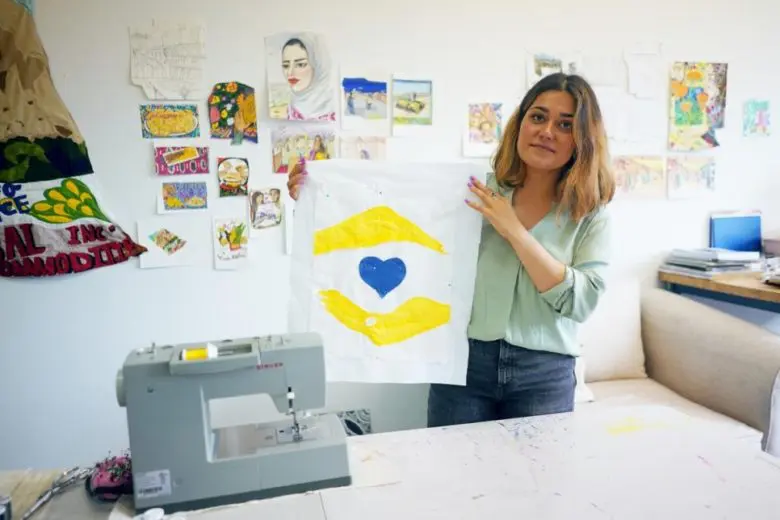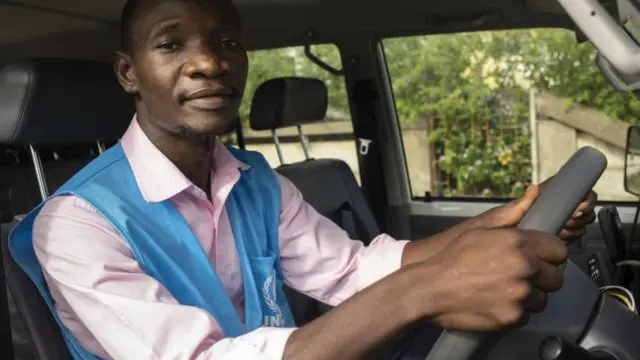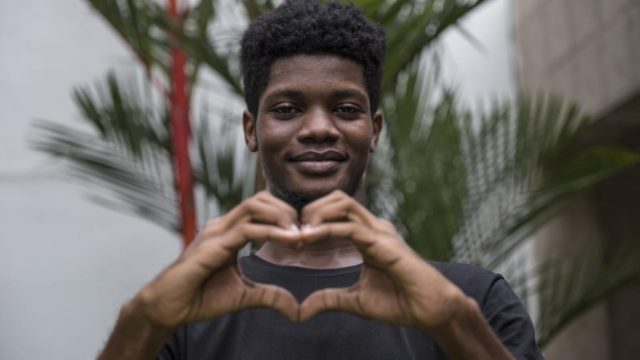
Hangama Amiri, the designer of the 2021 World Refugee Day Twitter emoji, in her studio in New Haven, Connecticut, USA. © UNHCR/Ashley Le
Hangama Amiri reflects on growing up as an Afghan refugee, becoming a Canadian artist and creating the emoji for World Refugee Day
By Taraneh Kelishadi in New Haven, Connecticut, USA
Hangama Amiri was seven years old when the Taliban invaded Kabul in 1996. War and chaos ravaged her neighborhood, leaving her family no choice but to flee. Forced to leave their community, they embarked on an arduous journey in search of safety, going first to Pakistan and later Tajikistan before being resettled in Canada in 2005.
As her family moved from one place to the next, Hangama always carried pencil and paper. Drawing her experiences at an early age gave her a “sense of freedom,” she says. Today, at age 31, she has turned that early practice into a successful career as an artist. Her colourful textile pieces, which recall and reconfigure her hometown of Kabul, are on view in galleries around the world.
Now Hangama has designed an emoji that is being launched today by UNHCR, the UN Refugee Agency, and Twitter, to mark World Refugee Day. The emoji, which will be available on Twitter from 13 to 23 June, features a blue heart cupped between two hands.
Sitting in her sunlit studio near the Yale University campus, where she graduated in 2020 with a Master of Fine Arts degree, Hangama answered some of our questions about art, home and hope. The conversation has been edited for length and clarity.
Tell us about how you became an artist and what art means to you.
I became interested in drawing when I was a child, when I became a refugee after the war in Afghanistan. When we were living in Tajikistan, there was an art programme by UNHCR which offered refugee children the chance to create art, to be busy with their imagination. There was also a competition, and for this competition I drew a reconstruction of the Twin Buddhas that were destroyed in 2001 by the Taliban. It was a really hopeful image for Afghanistan. That piece got the first prize and, luckily, I got into a college of art and design in Dushanbe, Tajikistan. Since then, I’ve still been making art, and I’m the most privileged person to be an artist today.

Hangama Amiri, the designer of the 2021 World Refugee Day Twitter emoji, in her studio in New Haven, Connecticut, USA © UNHCR/Ashley Le
Can you tell us more about the design you’ve created and the message behind it?
I decided to come up with an idea around hope and togetherness and love at the same time. I think these three words are really strong in relation to what immigration or being a refugee means. It’s the togetherness. It’s to have my family around me. It’s to have the love around me because those are the only things that we hold on to. I also wanted to make something very simple but also very powerful. The hand is a very strong gesture. The heart, which is a very simple shape, is also universal. I wanted to do this gesture of one hand coming from the East and the other coming from the West – that from East and West, we are supporting this love that’s held in between. The color of the heart is also blue, which means the blue Earth.
Who are the people whose impact you carry with you everywhere you go?
The figure that has always had played a huge role for me as an artist is my mother. Being beside her and having seen her experiences moving from country to country, I think she is one of the strongest women I’ve ever known. I think about my aunts as well – the women in Afghanistan in general. They are the bravest survivors.
Has art been a way to deal with uncertainty throughout your journey?
It’s not that art gives me an answer, but that creating art gives me an awareness of something. I don’t prefer everything to be so perfect in my world because my world was never perfect, and it never will be because I’m still living in a foreign land. So that imperfection makes so much sense in my world to express.
One of the strengths that kept me going was my childhood memories – those fragile childhood memories that I still carry until today. As a child, seeing war, or seeing other conflicts in the public or in the whole country, you don’t know what’s going on. These memories and experiences just kept on growing and growing. And that’s why whenever I start work, I always go back and revisit these memories and try to see what sort of stories I’m going to paint or draw today. Working with memory is one of the strengths for me to learn about myself and who I am as an artist.
Tell us about what home means to you.
These days, home is a memory for me. It’s become more of a feeling than really thinking of home as a territory or as a physical thing. Home is in my heart. But it’s a thing that I cannot smell, that I cannot touch, that I cannot walk on the ground of. I [have many] homes. My studio is a home for me sometimes because it gives me a sense of freedom, a sense of who I am, a sense of maybe peace. Afghanistan will always be in my work.
SIGN UP FOR UNHCR’S NEWSLETTER
What do you hope for the future?
One of my future goals as an artist is to someday go back to Afghanistan and open up an art institution. I want to create that community of artists and invite them to be in this creative zone.
Originally published by UNHCR on 14 June 2021





